Header logo
header top contact widget
LANAP
Nothing To Fear To Accomplish Healthy Smile Here
Posted on Apr 16, 2023 by William J. Claiborne, DDS MS
As a dental specialist, I find that many people are unfamiliar with exactly what a periodontist does. Yet, when they are recommended to see me (typically by their general dentist), it is because they need specialized care that falls under our unique set of skills.
A periodontist has advanced skills to help patients with a variety of needs that involve the gum tissues. These include:
– Treatment of all stages of gum disease (gingivitis, pregnancy gingivitis, periodontal disease, periodontitis)
– Reshaping gum tissues for esthetic enhancement (crown lengthening, gingivectomy for ‘gummy smiles’, repairing areas of gum recession)
– Diagnosis and placement of dental implants
– Treatment of lesions or cysts in oral tissues
Let’s begin with gum disease.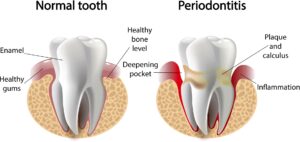
Because the majority of care I provide has to do with the treatment of all stages of periodontal disease, it may be helpful to understand how this develops. Although many people delay or avoid regular dental care (mistakenly thinking “if nothing hurts, then nothing must be wrong”), I have a close-up view of its destructive nature. Its formation creates cavities, periodontal (gum) disease, and leads to eventual tooth loss.
Even people who are committed to a regimen of thorough at-home oral hygiene (twice-daily brushing, daily flossing), can be doing an insufficient job of removing the daily buildup of plaque. Plaque is a sticky film of bacteria that accumulates in the mouth. When not thoroughly removed, it can harden into a mass that attaches to the base of, or in-between, teeth.
In the form of tartar, this cement-hard mass of bacteria cannot be brushed or flossed away. Once tartar forms, it can only be removed by a dentist or hygienist using special tools. Without removal, it will continue to amass and attack gum tissues, working its way beneath the gum line.
Below the gums lie the support system for natural teeth, consisting of tissues, ligaments and bone. When the bacteria reach an uncontrollable level, they become infectious. As these infectious bacteria accumulate further, symptoms of gum disease become more apparent, such as tender or swollen gums or seeing blood in the sink when brushing teeth. Breath odor may be bad on a regular basis.
As symptoms worsen, the gums become red with infectious and loosen their grip around the base of teeth. The gums may become spongy and pus pockets may form. Breath odor at this point is persistently putrid. Eventually, the structures that support teeth are compromised and teeth may loosen. Gum disease is the leading cause of adult tooth loss in the U.S.
Research has found that certain strains of oral bacteria from gum disease create reactions in the body that can trigger systemic inflammation. Thus far, research findings have shown a correlation between periodontal disease bacteria and some cancers (including pancreatic and lung), Alzheimer’s disease, pre-term babies, heart disease, stroke, diabetes, arthritis and erectile dysfunction (ED).
As if all that weren’t bad enough, one study suggests that gum disease relates to a reduction in one’s quality of life: “Periodontal disease has been linked to lower quality of life.” “Quality of life encompasses several domains, including psychological functioning and social relationships among others. Oral health-related quality of life has been shown to be reduced in patients with periodontal disease.” (https://www.hindawi.com/journals/prm/2017/5491923/)
While estimates show about 75 percent of American adults have some degree of dental fear or anxiety, over 47 percent have some level of periodontal disease. As a periodontist, both are alarming numbers. Nearly half our nation is walking around with a potentially life-threatening disease in their mouths.
Treating this may sound like it would be pretty intimidating. However, Although there are many treatments offered and at various levels, our main goal is to provide patients with comfortable and positive experiences at every visit. One way we accomplish this is through the advanced technology featured here in our Western North Carolina periodontal dental office. We feature some of the most advanced in dentistry, much of which is not available in dental offices elsewhere. Some of these features include:
LANAP With PerioLase MVP 7: Laser-Assisted New Attachment Procedure is an advanced protocol that efficiently and effectively treats advanced gum disease with the added advantages of a dental laser. This offers a non-surgical alternative for patients with moderate to severe periodontal disease. LANAP treatment leaves very little discomfort and has a quick recovery time. It has also been found to stimulate bone regrowth in damaged areas.
3D Cone Beam Imaging: Ideal for diagnoses and treatment planning, these images provide a clear view of the upper and lower jaw, used for: intricate review of endodontics; periodontics; orthodontics; implantology: TMJ; and prosthodontics, as well as dental and maxillofacial surgery. Because cone beam radiographs show sagittal, axial, and coronal planes, locating and tracking nerve canals optimizes implant placement. The process is quick, painless and at minimal levels of radiation.
CareStream Cone Beam Computer Tomography Imaging: This enhanced tomography works with 3D imaging for exceptional detail and range.
CS 3600 Intraoral Scanner: Rather than make impressions with bulky, goopy trays, this scanner quickly and comfortably captures digital impressions accurately and easily for creating precision models or appliances (crowns, inlays, onlays, bridges, orthodontic appliances and aligners, custom abutments). The scanner can also reach difficult–to–access areas in the patient’s mouth for superior results with improved patient comfort.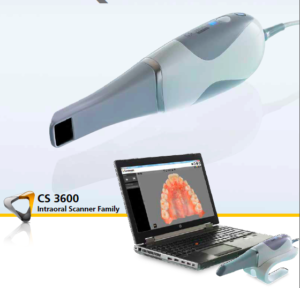
Computerized Dental Implant Placement: This advanced system for pre-surgical positioning of dental implants uses a 3D model of the patient’s jaw. Once the implant type is selected, a template is developed for optimal treatment success, even for complex cases.
In addition, we offer a unique environment for comfort. We understand how dental fear or anxiety can cause people to delay or avoid having dental treatment, sometimes for decades. We believe that every patient deserves respect, a gentle touch and knowing they are in a “lecture free” zone. For those who have high fear levels, we offer several sedation options, including oral and IV sedation.
Oral sedation is a pill that helps patients relax. It also has an amnesiac effect, leaving most with little or no memory of treatment afterward.
I.V. sedation (also known as ‘twilight sleep’) places the patient in a deeper sleep state and erases memory of the procedure. It is administered by a doctor of anesthesiology for optimal comfort and safety. In our Asheville office, anesthesia is overseen by a Medical Doctor (MD) who is a board certified Anesthesiologist.
With both sedation options, patients are closely monitored with advanced safety equipment throughout treatment.
I hope I’ve given you a helpful and positive picture of what a periodontist does and how he/she can help you with some challenging needs; all the while keeping you comfortable, minimizing treatment time, and shortening treatment time.
Although most of our patients are referred to us by other dentists and dental specialists, a referral is not required for accepting a new patient. Call 828-274-9440 if you feel we can make recommendations for your specific needs or provide helpful information.
“Gray Tsunami” Brings New Numbers in Dementia, Alzheimer’s
Posted on Feb 11, 2023 by William J. Claiborne, DDS MS
The American Academy of Periodontology (perio.org), defines a periodontist as:
“A periodontist is a dentist who specializes in the prevention, diagnosis, and treatment of periodontal disease, and in the placement of dental implants. Periodontists are also experts in the treatment of oral inflammation. Periodontists receive extensive training in these areas, including three additional years of education beyond dental school. They are familiar with the latest techniques for diagnosing and treating periodontal disease, and are also trained in performing cosmetic periodontal procedures.”
As an Asheville periodontal specialist for over 25 years, my advanced skills help patients with a variety of needs that involve the gum tissues. These include:- Treatment of all stages of gum disease (gingivitis, pregnancy gingivitis, periodontal disease, periodontitis)
– Reshaping gum tissues for esthetic enhancement (crown lengthening, gingivectomy for ‘gummy smiles’, repairing areas of gum recession)
– Diagnosis and placement of dental implants
– Treatment of lesions or cysts in oral tissues
Why should you be concerned about the health of your gums?
Gum disease is an inflammatory disease that attacks gum tissues, teeth, and the structures that support them. It is the nation’s leading cause of adult tooth loss. As if that weren’t bad enough, research has shown that these potent bacteria are able to activate the development (or worsen the progress) of other diseases.
Past studies have shown oral bacteria from gum disease can be a contributing factor to heart disease, stroke, some cancers, diabetes, preterm babies, erectile dysfunction (ED), high blood pressure, and impotency. Studies have begun to closely study the links between gum disease and Alzheimer’s disease.
In the U.S., the growing prevalence of dementia and Alzheimer’s disease is an especially concerning issue as our aging population grows. If you are a “baby boomer” (born between the years 1946 – 1964), you make up a significant percentage of adults. Within 7 years, boomers” will comprise 21% of the population. By 2060, nearly 1 in 4 Americans will be 65 years and older, dubbed the “gray tsunami.” Seniors over the age of 85 will have tripled, with half a million adults having reached age 100-plus.
While the statistics of aging adults increase, these stats for ALL adults over the age of 30 should set off some alarms. Nearly half of the adult population has some level of gum disease, over 47%.
There is a misconception many have when it comes to the serious nature of gum disease. Too often, people perceive “if it doesn’t hurt, then nothing is wrong” when it comes to their oral health. Although symptoms of gum disease may include tender gums that bleed when brushing, gum disease can begin without any obvious signs.
This is true for many health problems. For instance, when cancer forms in the body, its initial presence isn’t obvious. This is why annual or periodic screenings are urged since treatment is typically minimal during early stages.
Early treatment, including that for gum disease, helps to resolve the problem without complex measures. This is why it is so important to have 6-month dental check-ups. These visits allow your dentist to catch gum disease early so treatment needs and expense can be minimal.
Yet gum disease is a hazard for your overall health as well. While gum disease forms in the mouth, that’s not necessarily where it remains without proper treatment. The bacteria of gum disease can enter the bloodstream. It has been found to trigger serious reactions elsewhere in the body. Some of these lead to the formation of cancer (oral, throat, pancreatic, lung) and some activate conditions such as diabetes and arthritis.
Obviously, the health of your mouth is an important part of supporting a healthy body, especially in disease prevention. To illustrate the extent of gum disease’s damaging impact to health, research is tracking its correlation to dementia and Alzheimer’s disease.
In a recent study that included over 8,200 adults, an increased risk for developing dementia was found in those having severe gum disease and missing teeth. Participants in the study had an average age of 63 at the study’s onset.
In a follow-up after 18 years, those who had severe gingivitis in addition to tooth loss had a 22% higher risk for developing Alzheimer’s disease or dementia. Having no natural teeth was associated with a 26% increased risk.
Broken down, 14% of individuals with healthy gums and all their teeth at the start of the study developed dementia by the end of the study. For those with mild gum disease, 18% (623 out of 3,470) developed dementia. Twenty-two percent of participants with severe gum disease developed dementia. For those who had no remaining teeth, 23% developed dementia – nearly 17 cases for every 1,000 persons.
They found the bacteria present in periodontal disease can travel through the mucous membranes of the mouth to the brain, potentially causing brain damage.
In the study, participants were carefully assessed based on age, gender, education, cholesterol, high blood pressure, coronary heart disease, smoking and body weight. (https://psychcentral.com/news/2020/07/30/gum-disease-may-be-linked-to-later-dementia/158497.html?MvBriefArticleId=25473)
Prior studies have led researchers to be more focused on tracking oral tissue related factors that may contribute to dementia and Alzheimer’s disease, which is affecting a growing percentage of American adults (as well as those globally). Currently, 10% of adults age 65 and over have Alzheimer’s disease. For people ages 85 and older, this increases to 32 percent. In the U.S., it is the 6th leading cause of death. (https://www.alzheimers.net/resources/alzheimers-statistics/)
By the year 2025, the number of people 65 and older with Alzheimer’s disease is expected to reach 7.1 million people, a 27 percent increase from the 5.6 million age 65 and older in 2019.
Let us help you minimize the risks associated with oral bacteria. If dental fear has kept you from having regular dental care, we will be happy to discuss our many comfort options in our comfortable Asheville office, including Oral and I.V. sedation (“twilight sleep”).
Oral sedation is a pill that helps patients relax. It also has an amnesiac effect, leaving most with little or no memory of treatment afterward. I.V. sedation (also known as ‘twilight sleep’) places the patient in a deeper sleep state and erases memory of the procedure. It is administered by a doctor of anesthesiology for optimal comfort and safety.
Here, our Western North Carolina periodontal dental office also features some of the most advanced technology in dentistry. Many of these are not available in other dental offices elsewhere. Some of these features include LANAP (Laser-Assisted New Attachment Procedure. This is an advanced protocol that efficiently and effectively treats advanced gum disease with the added advantages of a dental laser. We also have 3-D Cone Beam Imaging, computerized Tomography imaging and one of the latest in intraoral scanners.
Now, more than ever, we know that maintaining a healthy smile is important and achievable for every adult. If you suspect you have gum disease (gums that bleed when brushing, tender or swollen gums, gums that have reddened or receded from teeth), it is important to be seen by a periodontist. A periodontal specialist is the best way to restore any level of gum disease to help you regain a healthy smile.
Be committed to having excellent oral health as and make it a priority as an important part of your overall health. For a consultation to discuss how a periodontist can help you, call 828-274-9440.
Dental Implants – Proper Implant System & Precision Placement
Posted on Dec 13, 2022 by William J. Claiborne, DDS MS
A periodontist specializes in the diagnosis and placement of dental implants, in addition to the treatment of all stages of periodontal disease.
In our Asheville periodontal dental office, many general dentists refer patients to us for dental implants. With our specialized skills and advanced technology, we can diagnose and place the implanted portion for optimal comfort and success in treatment outcome.
We are also able to offer patients a wider variety of choices when it comes to implant systems.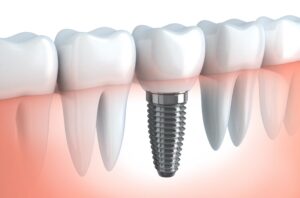
There are many types of dental implants. Various systems are designed to support one replacement tooth (the “restoration”), a bridge of two or more teeth, or a full denture supported by several strategically-placed implants. Understanding the unique advantages of all systems enables us to choose the best type for the patient’s individual needs and goals.
For example, the All On 4 dental implant system is designed to support non-removable teeth on just 4 implants (per arch). With its specially-designed implanted portions, these longer implants can fully distribute biting and chewing forces.
The All-On-4 option is an ideal choice for people who have lost bone mass due to lengthy periods of tooth loss. Because All On Four can be placed in minimal bone, many patients are able to avoid the need for bone rebuilding procedures prior to traditional implant placement.
However, it is not just in selection of the implant that a periodontist offers, it is in the placement skills. For a dental implant to serve as a lasting tooth replacement system, it must be positioned in the jaw bone to specific depths and angles. An implant that is mis-positioned can function less efficiently and lead to the need for removal.
Patient comfort can also be enhanced through the specialized care of a periodontist.
Because a periodontal specialist is uniquely skilled in the care of gum tissues, he or she is able to provide a conservative approach to the placement process. Through respectful treatment of oral tissues (in both placement and exposure for restorations), less disruption to the gums allows for faster healing and higher comfort levels.
In our Western NC periodontal dental office, we also feature some of the most advanced technology in dentistry; many options which are not readily available in other dental offices in our region. These computerized images offer advantages to patients in helping to minimize treatment needs.
Some features include:
Computerized Dental Implant Placement – This advanced system for pre-surgical positioning of dental implants uses a 3D model of the patient’s jaw. Once the implant type is selected, a template is developed for optimal treatment success, even for complex cases.
3-D Cone Beam Imaging – Ideal for diagnoses and treatment planning, these images provide a clear view of the upper and lower jaw, used for: intricate review of tooth roots; periodontics; orthodontics; dental implants: TMJ; and prosthodontics, as well as dental and maxillofacial surgery. Because cone beam radiographs show sagittal, axial, and coronal planes, locating and tracking nerve canals optimizes implant placement. The process is quick, painless and at minimal levels of radiation.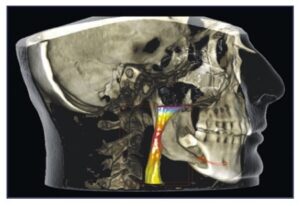
CareStream Cone Beam Computer Tomography Imaging – This enhanced tomography works with 3D imaging for exceptional detail and range.
LANAP With PerioLase MVP 7 (Laser-Assisted New Attachment Procedure) – Is an advanced protocol that efficiently and effectively treats advanced gum disease with the added advantages of a dental laser. This offers a non-surgical alternative for patients with moderate to severe periodontal disease. LANAP treatment leaves very little discomfort and has a quick recovery time. It has also been found to stimulate bone regrowth in damaged areas.
CS 3600 Intraoral Scanner – Rather than make impressions with bulky, goopy trays, this scanner quickly and comfortably captures digital impressions accurately and easily for creating precision models or appliances (crowns, inlays, onlays, bridges, orthodontic appliances and aligners, custom abutments). The scanner can also reach difficult–to–access areas in the patient’s mouth for superior results with improved patient comfort.
When it comes to comfort, we are able to offer patients the highest level of relaxation through I.V. sedation (“twilight sleep”). Also available is oral sedation, which is in pill form for enhanced relaxation. While both options have an amnesiac effect, I.V. sedation places the patient in a deeper sedative state. It is administered by a doctor of anesthesiology for optimal comfort and safety. With both, patients are closely monitored with advanced safety equipment throughout treatment.
We know that dental fear is often the foundation of tooth loss, causing many adults to delay or avoid dental care for years. Here, our entire team are sincerely committed to patients in a compassionate and respectful manner.
After placement and restoration, it is important for dental implant patients to be highly committed to maintaining good oral hygiene. Although Dental Implants themselves do not experience decay, the gum tissues and bone supporting the implants are as susceptible to oral bacteria as before. When oral bacteria infection (gum disease) penetrates to the implant site positions, the only way to treat the infection may involve removal of the implant.
For a lifetime of confident smiles with your implants, we will work with your general dentist to help you maintain ideal oral health. This may involve instructions for thorough oral hygiene at home and dental check-ups scheduled for every four months rather than twice a year. During these visits, the condition of your gums will be assessed and a hygienist will remove accumulated oral bacteria to reduce risk to your implants.
Dental implants are designed to last a lifetime and are the closest thing to the natural teeth you once had. Too, the restored ability to bite, chew, speak and laugh without worry can be a tremendous boost to one’s self-esteem and self-confidence.
If you are considering dental implants to replace missing teeth, we invite you to begin with a consultation appointment. This will take place in a private room where we can discuss your needs and concerns. From there, you can determine what pace is best for you.
Call 828-274-9440 to schedule, or tap here for more contact information.
The “Why” & “How” of Dental Implants
Posted on Nov 09, 2022 by William J. Claiborne, DDS MS
According to the Centers for Disease Control & Prevention (CDC), over one-fourth (26%) of American adults ages 65 and older have 8 or less natural teeth. The CDC equates this number (having 8 or fewer teeth) as “severe tooth loss” since it impacts an individual’s ability to thoroughly eat a healthy diet.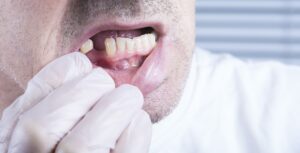
An even worse statistic shared by the CDC is 1 in 6 (17%) adults ages 65 and older have lost all of their teeth.
When it comes to losing natural teeth, they also share that the most vulnerable older adults are those who are poor, have less than a high school education, or are cigarette smokers.
Being totally edentulous (having lost all teeth) amongst the 65 or older age group has fortunately declined over the years. The CDC shared that the figure dropped by more than 30% from 1999–2004 (when it was 27%) to 17% in 2011–2016. At least American adults are moving in the right direction.
https://www.cdc.gov/oralhealth/fast-facts/tooth-loss/index.html
Tooth loss is a bigger deal than is assumed by a large segment of the population. When a natural tooth is removed, its absence causes a reaction that begins below the gum line. What occurs initially is typically not obvious. Yet, the repercussions of “resorption” can become quite the dilemma.
The absence of a tooth root in the upper or lower jaw bone is a loss of stimulation to the bone mass where it was once positioned. These roots provide both stimulation and nourishment that enables the bone to maintain a healthy mass. Without the presence of tooth roots, the bone begins to “melt away.” This process is known as resorption.
Think of the stimulation that tooth roots provide to how you might muscle atrophy. We all know that muscles, not used, will shrink in mass. When the jaw bones are lacking stimulation by the tooth roots they’re designed to hold, bone mass begins to shrink.
Resorption begins shortly after the tooth root is removed. Once it starts, it continues at an ever-increasing pace. For example, the first year after a tooth root is missing, the loss of bone may be minimal. With each passing year, the pace of loss accelerates.
As the bone shrinks in height, the natural tooth roots adjacent to the area of missing teeth are subject to movement and root damage. On average, the next teeth you’re most likely to lose are the ones bordering areas of missing teeth.
Obviously, it is important to replace lost teeth before bone loss begins. For the support of remaining natural teeth, it’s also important to replace missing teeth as soon as possible so adjacent teeth can retain their proper positions. And, it’s HOW you replace them that’s most important.
Because dental implants replace the tooth above the gum line AND the root portion below it, the bone is able to retain its mass. Through the sturdy foundation of the jaw bone, dental implants are able to restore the look, feel and chewing stability like that of natural teeth.
As a periodontist, I specialize in the prevention, diagnosis, and treatment of all stages of periodontal (gum) disease. I also have advanced training and skills in the selection and placement of dental implants. In addition, periodontists are particularly skilled in performing cosmetic periodontal procedures.
Our Western NC periodontal dental office features some of the most advanced technology available. This cutting edge technology is beneficial in a number of ways, with much specifically helpful in optimal dental implant diagnosis and planning. This includes:
LANAP With PerioLase MVP 7 – Laser-Assisted New Attachment Procedure is an advanced protocol that efficiently and effectively treats advanced gum disease with the added advantages of a dental laser. For patients who are preparing for dental implant placement, resolving gum disease prior to treatment is mandatory. LANAP offers a non-surgical alternative for patients with moderate to severe periodontal disease with very little discomfort and a quick recovery time.
Cone Beam Imaging – These amazing 3D “x-rays’ are ideal for diagnosing and treatment planning. The highly-detailed images provide a clear view of the upper and lower jaw. Because cone beam radiographs show sagittal, axial, and coronal planes, locating and tracking nerve canals optimizes implant placement. The images are captured in a quick, painless process and at minimal levels of radiation.
CareStream Cone Beam Computer Tomography Imaging – This enhanced tomography works with 3D imaging for exceptional detail and range.
Computerized Dental Implant Placement – This system provides the futuristic ability to position dental implants before the process actually begins. Through computerized technology, the implants are selected and “ideally positioned” on a 3D model of the patient’s jaw. From this, a template is developed for optimal treatment success, even for complex cases.
CS 3600 Intraoral Scanner – Rather than make impressions with bulky, goopy trays, this scanner quickly and comfortably captures digital impressions accurately and easily. These are used to create precision models or appliances (dental implant crowns, bridges, or full arches). The scanner can also reach hard–to–access areas in the patient’s mouth for superior results with improved patient comfort.
Sedation – Our Asheville periodontal practice is known for its environment of comfort and respectful care. We understand that over 70 percent of the adult population have some level of dental fear or anxiety. For optimal comfort and relaxation, we offer several sedation options, including oral and IV sedation. With both sedation options, patients are closely monitored with advanced safety equipment throughout treatment.
• Oral sedation is a pill that helps patients relax. It also has an amnesiac effect, leaving most with little or no memory of treatment afterward.
• I.V. sedation (also known as ‘twilight sleep‘) places the patient in a deeper sleep state and erases memory of the procedure. It is administered by a Medical Doctor (MD) who is a board certified Anesthesiologist.
Ideal diagnosis is important, and can save the patient much in overall treatment costs. For example, when missing more than one tooth in one area, one implant can often hold two or a bridge of teeth. Several strategically-placed implants may also be used support a full arch of teeth.
Dental implants restore the ability to eat with stability, chew comfortably, laugh and speak with confidence. Dental implants do not decay and will never need root canals. They have an extremely high success rate, higher than any implant-in-bone option. And, Dental Implants are designed to last a lifetime. With proper selection and maintenance, they will never need replacing or repair.
Dental implants come in many sizes and shapes, each system designed to accommodate various needs and preferences. This means your implant can be chosen to suit your long-term goals.
Proper placement and support in caring for implants is an important part of a successful outcome. However, dental implants can fail. This is why a periodontal specialist can be an asset to your investment. When dental implants are chosen and placed by a Periodontist, he or she can select the one that will work best for you now and throughout your lifetime.
In our Asheville periodontal dental office, we combine technology with our advanced skills and compassionate approach to care so you can enjoy a comfortable, efficient experience that allows you to have optimal success.
Call 828-274-9440 to arrange a consultation. During this time, we can discuss treatment that can achieve your needs and goals as well as the process and anticipated costs.
Recent Posts
Categories
Archives
- September 2024
- August 2024
- July 2024
- June 2024
- May 2024
- April 2024
- March 2024
- February 2024
- January 2024
- December 2023
- November 2023
- October 2023
- September 2023
- August 2023
- July 2023
- June 2023
- May 2023
- April 2023
- March 2023
- February 2023
- January 2023
- December 2022
- November 2022
- October 2022
- September 2022
- August 2022
- July 2022
- June 2022
- May 2022
- April 2022
- March 2022
- February 2022
- January 2022
- December 2021
- November 2021
- October 2021
- September 2021
- August 2021
- July 2021
- June 2021
- May 2021
- April 2021
- March 2021
- February 2021
- January 2021
- December 2020
- November 2020
- October 2020
- September 2020
- August 2020
- July 2020
- June 2020
- May 2020
- April 2020
- March 2020
- February 2020
- January 2020
- December 2019
- November 2019
- October 2019
- September 2019
- August 2019
- July 2019
- June 2019
- May 2019
- April 2019
- March 2019
- February 2019
- January 2019
- December 2018
- November 2018
- October 2018
- September 2018
- August 2018
- July 2018
- June 2018
- May 2018
- April 2018
- March 2018
- February 2018
- January 2018
- December 2017
- November 2017
- October 2017
- September 2017
- August 2017
- July 2017
- June 2017
- May 2017
- April 2017
- March 2017
- February 2017
- January 2017
- December 2016
- November 2016
- October 2016
- September 2016
- August 2016
- July 2016
- June 2016
- May 2016
- April 2016
- March 2016
- February 2016
- January 2016
- December 2015
- November 2015
- October 2015
- September 2015
- August 2015
- July 2015
- June 2015
- May 2015
- April 2015
- March 2015
- February 2015
- January 2015
- December 2014
- November 2014
- October 2014
- September 2014
- August 2014
- July 2014
- June 2014
- May 2014
- April 2014
- March 2014
- February 2014
- January 2014
- December 2013
- November 2013
- October 2013
- September 2013
- August 2013
- July 2013
- June 2013
- May 2013
- April 2013
- March 2013
- February 2013
- January 2013
- December 2012
- November 2012
- October 2012
- September 2012
- August 2012
- July 2012
- June 2012


